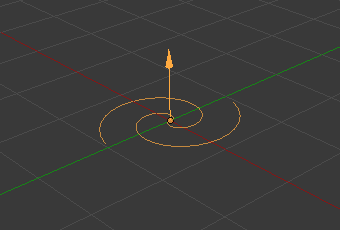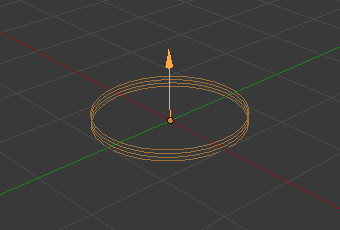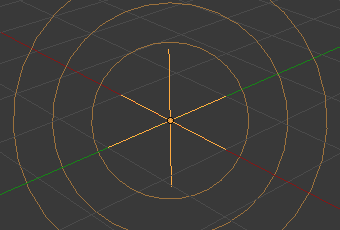Giới Thiệu (Introduction)
Force fields offer a way to influence a simulation, in example to add extra movement. Particles, Soft Bodies, Rigid Bodies, and Cloth objects can all be affected by forces fields. Force fields automatically affect everything. To remove a simulation or particle system from their influence, simply turn down the influence of that type of force field in its Field Weights panel.
All types of objects and particles can generate fields, but only curve object can bear a Hướng Đạo theo Đường Cong (Curve Guide) field.
Force fields can also be generated from particles. See Particle Physics.
The objects need to share at least one common layer to have an effect.
You may limit the effect on particles to a group of objects (see the Particle Physics page).
Tạo một Trường Lực (Creating a Force Field)
Tham Chiếu (Reference)
- Chế Độ (Mode)
Chế Độ Đối Tượng (Object Mode)
- Trình Đơn (Menu)
- Panel (Bảng)
To create a single force field, you can select and select the desired force field. This method creates an empty with the force field attached.

Vortex force field. |

Wind force field. |

Bắt Buộc Tái Nạp. |
To create a field from an existing object you have to select the object and change to the Physics tab. Select the field type in the Fields menu.
Ghi chú
After changing the fields Fields panel or deflection Collision panel settings, you have to recalculate the particle, soft body or cloth system by Free Cache, this is not done automatically.
Particles react to all kinds of force fields, soft bodies only to Force, Wind, Vortex (they react on Harmonic fields but not in a useful way).
Các Sắp Đặt Trường Thông Thường (Common Field Settings)
Most fields have the same settings, even though they act very differently. Settings unique to a field type are described below. Curve Guide and Texture fields have very different options.
- Hình Dạng (Shape)
Sets the direction which is used to calculate the effector force. For force fields from an empty object only Point, Line and Plane shapes are available, as for a field from a 3D object there are additional Surface and Every Point options, and Curve for a field from a curve.
- Điểm/Chấm (Point)
Point with omni-directional influence. Uses the object origin as the effector point.
- Đường Nét/Thẳng/Dòng (Line)
The force only acts in the local XY plane, using the Z axis line as the effector.
- Bình Diện (Plane)
The force only acts in the local Z direction, using the XY axis plane as the effector.
- Bề Mặt (Surface)
The force field acts on a 3D object's surface. In this case, the Z axis is the surface normal.
- Mọi Điểm (Every Point)
Uses every vertex in the mesh object as an effector point.
- Độ Đậm/Sức Mạnh/Cường Độ (Strength)
The strength of the field effect. This can be positive or negative to change the direction that the force operates in. A force field's strength is scaled with the force object's scale, allowing you to scale up and down the scene, keeping the same effects.
- Lưu Luồng/Lượng (Flow)
If nonzero, this adds a drag force proportional and opposite to the point velocity.
This effectively re-interprets the force field so that the Strength to Flow ratio at a certain point defines the velocity of an "air flow" field, and objects are encouraged to follow the flow by the resistance caused by the Flow drag force.
- Tác Động (Affect)
- Địa Điểm (Location)
Influence the location of particles and other physics entities.
- Xoay Chiều (Rotation)
Influence the rotation of particles with Dynamic Rotation. The option is not relevant for other types of physics systems.
Disabling both options completely deactivates the force field.
- Lượng Nhiễu Loạn (Noise Amount)
Adds noise to the strength of the force.
- Seed (Mầm)
Changes the seed of the random noise.
- Độ Hấp Thụ (Absorption)
Lực bị hấp thụ bởi đối tượng va đập.
- Hệ Số Gió (Wind Factor)
Specifies how much the force is reduced when acting parallel to a surface, e.g. cloth. If set to 1, only the normal component of the force is taken into account.
Suy Giảm Dần (Falloff)
Here you can specify the shape of the force field (if the falloff Power is greater than 0).
- Hình Dạng (Shape)
- Hình Nón (Cone)
The falloff results in a cone-shaped force field. Additional options are the same as those of Tube options.
- Hình Cầu (Sphere)
The falloff is uniform in all directions, as in a sphere.
- Hình Ống (Tube)
The falloff results in a tube-shaped force field. The field's Radial Power can be adjusted, as well as the Minimum and Maximum distances of the field.
- Hướng Z (Z Direction)
Chiều hướng lực tác động trên trục Z.
- +Z
The force only has an affect on the positive Z axis.
- -Z
The force only has an affect on the negative Z axis.
- Cả Hai Chiều Z (Both Z)
The force has an affect on the positive and negative Z axis.
- Công Suất/Năng Lượng/Sức Mạnh/Lũy Thừa (Power)
How the power of the force field changes with the distance from the force field. If r is the distance from the origin of the object, the force changes with 1/(r - min + 1)power. A falloff of 2 changes the force field with 1/(r - min + 1)2, which is similar to the falloff of gravitational pull.
- Khoảng Cách Tối Thiểu (Min Distance)
The distance from the object's origin, up to where the force field is effective with full strength. If you have a falloff of 0, this parameter will have no effect, because the field is effective with full strength up to Max Distance (or infinite). Shown by an additional circle around the object.
- Khoảng Cách Tối Đa (Max Distance)
Specifies the maximum radius in which the force field affects other objects (shown by an additional circle around the object).